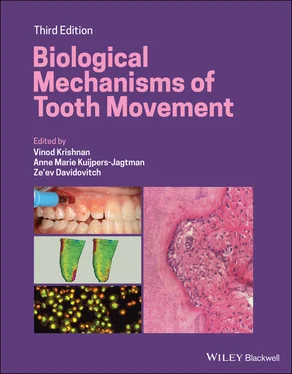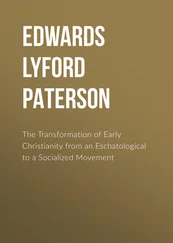173 Vandevska‐Radunovic, V., Kvinnsland, S. and Kvinnsland, I. H. (1997) Effect of experimental tooth movement on nerve fibres immunoreactive to calcitonin gene‐related peptide, protein gene product 9.5, and blood vessel density and distribution in rats. European Journal of Orthodontics 19, 517–529.
174 Varella, A. M., Revankar, A. V. and Patil, A.K. (2018) Low‐level laser therapy increases interleukin‐1β in gingival crevicular fluid and enhances the rate of orthodontic tooth movement. American Journal of Orthodonics and Dentofacial Orthopedics 154, 535–544.e5. doi: 10.1016/j.ajodo.2018.01.012.
175 Villa, I., Mrak, E., Rubinacci, A. et al. (2006) CGRP inhibits osteoprotegerin production in human osteoblast‐like cells via cAMP/PKA‐dependent pathway. American Journal of Physiology and Cell Physiology 291, C529–37.
176 Wang, J., Wu, D., Shen, T. et al. (2015) Cognitive behavioral therapy eases orthodontic pain: EEG states and functional connectivity analysis. Oral Diseases 21, 572–582.
177 Wei, F., Yang, S., Xu, H. et al. (2015) Expression and function of hypoxia inducible factor‐1α and vascular endothelial growth factor in pulp tissue of teeth under orthodontic movement. Mediators of Inflammation 2015:215761. doi: 10.1155/2015/215761.
178 Wolf, M., Lossdörfer, S., Küpper, K. and Jäger A. (2014a) Regulation of high mobility group box protein 1 expression following mechanical loading by orthodontic forces in vitro and in vivo. European Journal of Orthodontics 36, 624–631.
179 Wolf, M., Lossdörfer, S., Römer, P. et al. (2014b) Anabolic properties of high mobility group box protein‐1 in human periodontal ligament cells in vitro. Mediators of Inflammation 2014:347585. doi: 10.1155/2014/347585.
180 Wolf, M., Lossdörfer, S., Römer, P. et al. (2016) Short‐term heat pre‐treatment modulates the release of HMGB1 and pro‐inflammatory cytokines in hPDL cells following mechanical loading and affects monocyte behavior. Clinical Oral Investigation 20, 923–931. doi: 10.1007/s00784‐015‐1580‐7.
181 Wolf, M., Lossdorfer, S., Abuduwali, N. Jager, A. (2013) Potential role of high mobility group box protein 1 and intermittent PTH (1‐34) in periodontal tissue repair following orthodontic tooth movement in rats. Clinical Oral Investigations 17, 989–997.
182 Xu, X., Zhang, L., Jiang, Y. et al. (2013) [Clinical research of music in relieving orthodontic pain.] Hua Xi Kou Qiang Yi, Xue, Za Zhi 3, 365–368. (Chinese)
183 Yago, T., Nanke, Y., Ichikawa, N. et al. (2009) IL‐17 induces osteoclastogenesis from human monocytes alone in the absence of osteoblasts, which is potently inhibited by anti‐TNF‐α antibody: a novel mechanism of osteoclastogenesis by IL‐17. Journal of Cellular Biochemistry 108, 947–955.
184 Yamada, K., Yamaguchi, M., Asano, M. et al. (2013) Th17‐cells in atopic dermatitis stimulate orthodontic root resorption. Oral Diseases 19, 683–693.
185 Yamaguchi, M. and Kasai, K. (2007) The effect of orthodontic mechanics on the dental pulp. Seminars in Orthodontics 13, 272–280.
186 Yamaguchi, M., Aihara, N. and Kojima, T. (2006) RANKL increase in compressed periodontal ligament cells from root resorption. Journal of Dental Research 85, 751–756.
187 Yamaguchi, M., Kojima, T., Kanekawa, M. et al. (2004) Neuropeptides stimulate production of interleukin‐1 beta, interleukin‐6, and tumor necrosis factor‐alpha in human dental pulp cells. Inflammation Research 5, 199–204.
188 Yamaguchi, M., Shimizu, N., Goseki, T. et al. (1994) Effect of different magnitudes of tension force on prostaglandin E2 production by human periodontal ligament cells. Archives of Oral Biology 39, 877–884.
189 Yamaguchi, M., Ukai, T., Kaneko, T. et al. (2008) T cells are able to promote lipopolysaccharide‐induced bone resorption in mice in the absence of B cells. Journal of Periodontal Research 43, 549–555.
190 Yamaguchi, M., Yao‐Umezawa, E., Tanimoto, Y. et al. (2016) Individual variations in the hardness and elastic modulus of the human cementum. Journal of Hard Tissue Biology 25(4), 345–350.
191 Yamamoto, T., Kita, M., Kimura, I. et al. (2006) Mechanical stress induces expression of cytokines in human periodontal ligament cells. Oral Diseases 12, 171–175.
192 Yamasaki, K. (1983) The role of cyclic AMP, calcium, and prostaglandins in the induction of osteoclastic bone resorption associated with experimental tooth movement. Journal of Dental Research 62, 877–881.
193 Yamasaki, K., Miura, F. and Suda, T. (1980) Prostaglandin as a mediator of bone resorption induced by experimental tooth movement in rats. Journal of Dental Research 59, 1635–1642.
194 Yamasaki, K., Shibata, Y. and Fukuhara, T. (1982) The effect of prostaglandins on experimental tooth movement in monkeys (Macaca fuscata). Journal of Dental Research 61, 1444–1446.
195 Yamasaki, K., Shibata, Y., Imai, S. et al. (1984) Clinical application of prostaglandin E1 (PGE1) upon orthodontic tooth movement. American Journal of Orthodontics 85, 508–518.
196 Yang, C. Y., Jeon, H. H., Alshabab, A. et al. (2018) RANKL deletion in periodontal ligament and bone lining cells blocks orthodontic tooth movement. International Journal of Oral Science 10(1), 3. doi: 10.1038/s41368‐017‐0004‐8.
197 Yao, Z., Painter, S. L., Fanslow, W. C. et al. (1995) Human IL‐17: a novel cytokine derived from T cells. Journal of Immunology 155, 5483–5486.
198 Yao‐Umezawa, E., Yamaguchi, M., Shimizu, M. et al. (2017) Relationship between root resorption and individual variation in the calcium/phosphorous ratio of cementum. American Journal of Orthodontics and Dentofacial Orthopedics 152, 465–470.
199 Yu, W., Zhang, Y., Jiang, C. et al. (2016) Orthodontic treatment mediates dental pulp microenvironment via IL17A. Archives of Oral Biology 66, 22–29.
200 Zhang, F., Wang, C. L., Koyama, Y. et al. (2010) Compressive force stimulates the gene expression of IL‐17s and their receptor in MC3T3‐E1 cells. Connective Tissue Research 51, 359–369.
201 Zou, Y., Xu, L. and Lin, H. (2019) Stress overload‐induced periodontal remodeling coupled with changes in high mobility group protein B1 during tooth movement: an in‐vivo study. European Journal of Oral Science 127, 396–407.
Конец ознакомительного фрагмента.
Текст предоставлен ООО «ЛитРес».
Прочитайте эту книгу целиком, купив полную легальную версию на ЛитРес.
Безопасно оплатить книгу можно банковской картой Visa, MasterCard, Maestro, со счета мобильного телефона, с платежного терминала, в салоне МТС или Связной, через PayPal, WebMoney, Яндекс.Деньги, QIWI Кошелек, бонусными картами или другим удобным Вам способом.












